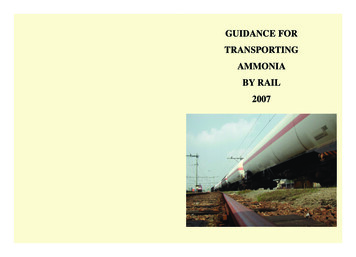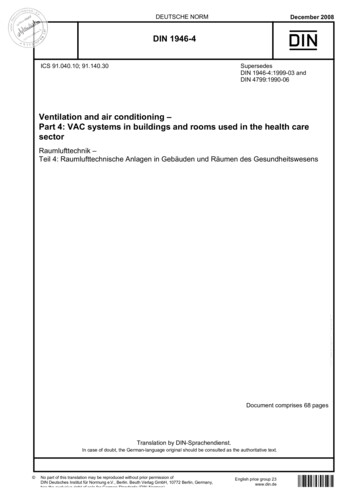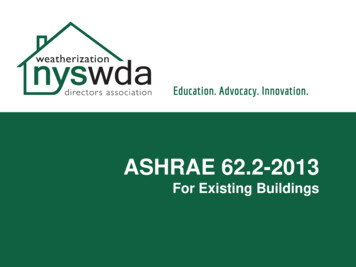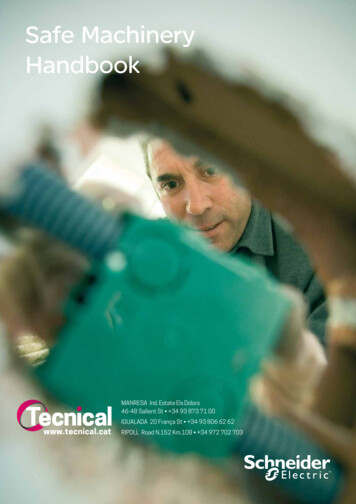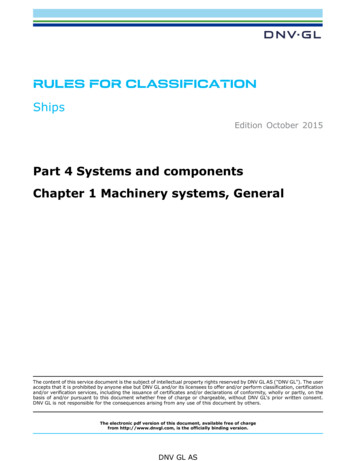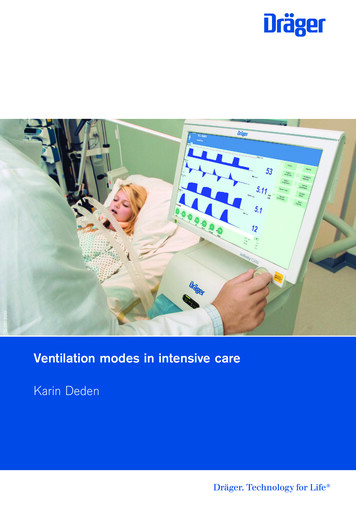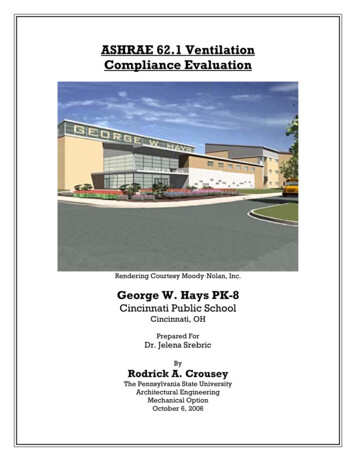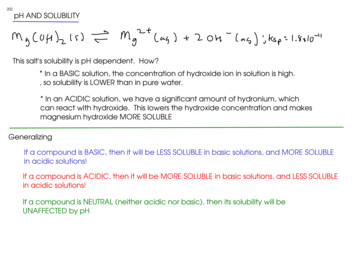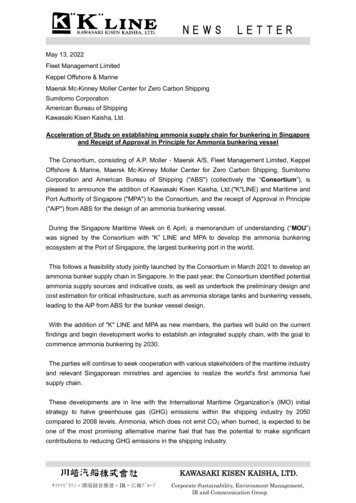
Transcription
ENGINEERING BULLETIN NO. 4DTC ENGINEERINGAMMONIA MACHINERY ROOM VENTILATIONREQUIREMENTSPUBLISHED BY DTC ENGINEERSJanuary 2020DUALTEMP CLAUGER4301 S. PACKERS AVE, CHICAGO, IL 60609www.dualtempclauger.comDUALTEMP CLAUGER ENGINEERING BULLETINJanuary 2020
ENGINEERING BULLETIN NO. 4DTC ENGINEERINGAMMONIA MACHINERY ROOM VENTILATION REQUIREMENTSOBJECTIVETo ensure safety by checking and preventing the accumulation of refrigerant in themachinery room due to a leak to a concentration that would be flammable, harmfulor result to oxygen deprivationREQUIREMENTSBased on the ANSI/IIAR-2 2014, the requirements for the machinery room is brokendown into three categories:1.2.3.Design and installationControlTesting1. DESIGN AND INSTALLATION1.1Machinery Room1.1.1 All components containing more than 320 ppm of Ammonia per occupiedspace should be in the machinery room.1.1.2 The rooms should be mechanically ventilated to the outdoors both undernormal and emergency conditions. Unless, the refrigerating system is located outdoors, at least 20-ftfrom the building opening and is enclosed by a penthouse, lean toor other open structure, natural or mechanical ventilation shall beprovided. Location of the opening shall be based on the relative density ofthe refrigerant to air.Page 1 of 10Ammonia Machinery Room Requirement Rev. 0.0January 2020
ENGINEERING BULLETIN NO. 4DTC ENGINEERING The free-aperture cross section for the ventilation of the machineryroom should not be less than:𝑭 𝑮Where:F The free opening area in square feet (m2)G The mass of the refrigerant in pounds (kg) in the largest system,any part of which is in the machinery room.1.1.3 The room ventilation requires detection to activate at 25 ppm, 150 ppm, andwhen a concentration exceeds the sensor’s upper detection limit or 40,000ppm (25% Lower Flammability Limit (LFL)).1.2Exhaust Discharge and Fan Requirement1.2.1 The exhaust air from mechanical ventilation systems should be dischargedto the outdoors at a point where it will not cause public nuisance. [6.14.3]1.2.2 The discharge location should be at least 20-ft from the property line oropenings to a building. [6.14.3.4]1.2.3 Despite the function, exhaust fans must have non-sparking blades and bethe totally enclosed type. [6.14.3.6, 6.14.3.7]1.2.4 The ventilation fans must have a minimum discharge velocity of 2,500 ft/min1.3 Make-up Air1.3.1 Make-up air should be provided from the outdoors to replace the exhaustair and maintain a negative pressure in the room. [6.14.5.1]1.3.2 Ventilation must not cause the negative pressure in the room to exceed 0.25inches water column. [6.14.5.1]1.3.3 Make-up intakes must serve ONLY the machinery room.Page 2 of 10Ammonia Machinery Room Requirement Rev. 0.0January 2020
ENGINEERING BULLETIN NO. 4DTC ENGINEERING1.3.4 The openings for the make-up air should be positioned cautiously to avoidshort-circuiting and the intake of the exhaust(contaminated) air. [6.14.5.2,6.14.5.4]1.3.5 Motorized louvers or dampers, where utilized, should fail to the openposition during a loss of power.1.3.6 Where direct openings are not provided, make-up should be provided byfans. [6.14.5.6]1.4Air Ducts1.4.1 The ducts for the make-up and exhaust air should serve ONLY the machineryroom. [6.14.3.3, 6.14.5.5]1.4.2 Make-up air duct must be covered with a corrosion-resistant screen of notless than ¼ inch mesh. [6.14.5.3]1.5Ventilation Rate1.5.1 Ventilation for OccupancyWhen occupied, the machinery room should be ventilated with outside air at arate of at least 0.5 cfm/ft2 of machinery room area or 20 cfm per person.Whichever of the two rates is greater should be used. [6.14.1]1.5.2 Emergency VentilationOn the activation of the refrigerant detector, the mechanical ventilation systemshould exhaust air from the machinery room in the following quantity:𝑸 𝟏𝟎𝟎 𝑮Where:Page 3 of 10Ammonia Machinery Room Requirement Rev. 0.0January 2020
ENGINEERING BULLETIN NO. 4DTC ENGINEERINGQ The airflow in cubic feet per minuteG The design mass of refrigerant in pounds (kg) in thelargest system, any part of which is in the machineryroom.1.5.3 According to IIAR-2 [2014], the minimum required emergency ventilationrate for Ammonia must be 30 air changes per hour based on the grossmachinery room volume.Except if analysis indicates that a release of the entire system charge will notresult in the room concentration exceeding 40,000 ppm (25% LFL). [6.14.7.1]1.5.4 Ventilation fans should discharge upwards at a minimum velocity of at least2,500 fpm at the required emergency ventilation (capacity) flow rate.[6.14.3.5]1.5.5 Multiple fans or multispeed fans are permitted to produce the emergencyventilation rate and temperature control. They can also be used to minimizethe airflow for normal ventilation. [6.14.4]1.6 Temperature control1.6.1 Temperature control ventilation should be activated before 104 F1.6.2 Considering the heat load of the machinery and the make-up air enteringthe room at 1% design, the temperature control ventilation must limit thedry bulb temperature to 104 F.Temperature control ventilation can be supplemented with the emergencyventilation.If supported by engineering design, such as external means of cooling orelectrical wiring rated for higher temperatures, reduced temperaturecontrol ventilation rate can be used. [6.14.6.1]Page 4 of 10Ammonia Machinery Room Requirement Rev. 0.0January 2020
ENGINEERING BULLETIN NO. 4DTC ENGINEERING1.6.3 Temperature control ventilation should be continuous and activated bothautomatically with a thermostat and manually with a control switch.Multiple fan or multispeed fan systems can be partially operated to deliverthe temperature control ventilation. [6.14.6.2]1.7 Emergency Control Switch1.7.1 A clearly identified control switch for emergency ventilation with a tamperresistant cover must be located outside the machinery room and adjacentto the designated principal machinery room door.1.7.2 The switch must provide ON/AUTO override capability and be distinctlylabeled. [6.12.2]1.8 Mechanical Ventilation Power System1.8.1 The system should be powered independent of the equipment in themachinery room and be unaffected by the emergency shut down controls.[6.14.7.3]2. CONTROLIn addition to the requirements stated in the design and installation section, thefollowing should be strictly adhered to in order to ensure safety.2.1 Ammonia Detection Thresholds2.1.1 The sensor should be located where a leak is most likely to occur2.1.2 Detection of less than 25 ppm of ammonia concentrations requires noalarm.2.1.3 Detection of ammonia concentrations of 25 ppm or more should activateaudible alarms and visual indicators, located inside the room, to warn that,Page 5 of 10Ammonia Machinery Room Requirement Rev. 0.0January 2020
ENGINEERING BULLETIN NO. 4DTC ENGINEERING2.1.42.1.52.1.62.1.72.1.8when the alarm is activated, access to the room is restricted to ONLYauthorized personnel and emergency responders.The detection should also activate an alarm that reports to a monitoredlocation to ensure a corrective action is taken at an indicatedconcentration of 25 ppm. [ANSI/IIAR 2-2014 & 17.7.1]Emergency ventilation must be automatically activated by the ammoniadetection system at a concentration of 150 ppm and by a manual controlswitch with manual reset required. [6.12.2, 6.13.2.3, 6.14.3.1, 6.14.7.2]Detection of 40,000 ppm or vapor detector’s upper limit must cause thefollowing equipment to automatically de-energize:a. Refrigerant compressorb. Refrigerant pumpsc. Normally closed automatic refrigerant valves that are not partof the emergency control system. [ANSI/IIAR 2-2014 & 6.13.2]In the event of a concentration above 150 ppm, general exhaust fans notused to provide emergency ventilation or temperature control must beshut off with refrigeration machinery. [6.14.2]In the event of power failure, a means of monitoring the ammonia releaseconcentration should be provided. [ANSI/IIAR 2-2014 & 16.1.4]2.2 Power loss and Emergency Ventilation Failure2.2.1 The events of power loss or ventilation failure must result in the sending ofa signal to a monitored location. [6.14.7.4].2.3 Signage2.3.1 Machinery Room Door Signs2.3.1.1 The entrances to the machinery room should be provided with signagewhich firstly, restricts the area to authorized personnel only andsecondly, indicates the proper NFPA 704 designation. [ANSI/IIAR 2-20146.15.1]Page 6 of 10Ammonia Machinery Room Requirement Rev. 0.0January 2020
ENGINEERING BULLETIN NO. 4DTC ENGINEERING2.3.1.2The details of the door signage, as recommended in the informativesection of IIAR 2-2014, Appendix J, are shown in Figure 1 and outlinedbelow:Refrigeration Machinery RoomAuthorized Personnel OnlyCaution – Ammonia R-717Caution – Eye and Ear Protection RequiredNFPA 704 – Ammonia Fire Diamond (Blue-3, Red-3, Yellow-0)2.3.2 Alarm Signs2.3.2.1 Signage should be placed next to the actual audio/visual alarms thatidentify these alarms as part of the ammonia detection system. Anexample is shown in Figure 2 below [ANSI/IIAR 2-2014 17.6]2.3.2.2 IIAR 2-2014 recommends the following details on the alarm signage:WarningWhen alarms are activated, Ammonia has been detected:1.2.3.Leave room immediatelyDo not enter except by Trained and Authorized personnelDo not enter without Personal Protective Equipment2.4Switch Signs2.4.1 It is highly recommended that the Refrigeration Stop Switch andEmergency Ventilation Switch be labelled like the alarm signs as shown inFigure 3 below.Page 7 of 10Ammonia Machinery Room Requirement Rev. 0.0January 2020
ENGINEERING BULLETIN NO. 4DTC ENGINEERINGFigure 2: An Illustration of the AlarmSignage with the Audio/Visual SystemFigure 3: Schematic Representation of the Stop Switchand Emergency Ventilation SwitchPage 8 of 10Ammonia Machinery Room Requirement Rev. 0.0January 2020
ENGINEERING BULLETIN NO. 4DTC ENGINEERING2.5System Installation Signage2.5.1 This is required by the California Mechanical Code [2016 CMC 1115.3].2.5.2 A system installation sign, as shown in Figure 4, should be permanentlyplaced and indicate the following details:2.5.2.1 Name of installing contractor2.5.2.2 Name and number designation of refrigerant in the system (e.g.Ammonia 717)2.5.2.3 Pounds of refrigerant in the systemFigure 4: An Example of a System Installation SignagePage 9 of 10Ammonia Machinery Room Requirement Rev. 0.0January 2020
ENGINEERING BULLETIN NO. 4DTC ENGINEERING3. TESTING3.13.2The testing schedule for ammonia detectors, alarms and the ventilationsystem should be established based on the manufacturer’s recommendationand/or a documented experience.Alternatively, the ventilation system should be tested at least twice a year ifno recommendation is given. [6.14.8]Page 10 of 10Ammonia Machinery Room Requirement Rev. 0.0January 2020
dualtemp clauger engineering bulletin january 2020 engineering bulletin no. 4 dtc engineering ammonia machinery room ventilation requirements published by dtc engineers january 2020 dualtemp clauger 4301 s. packers ave, chicago, il 60609 www.dualtempclauger.com. page 1 of 10

